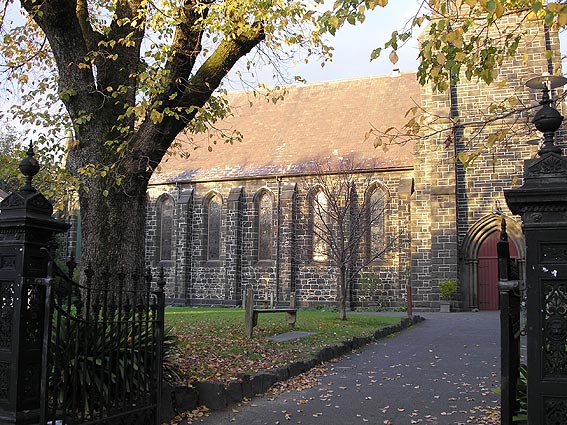
St Mark's Anglican Church, Fitzroy
[Photograph by Simon Colvin (May 2006)]

St Mark's Anglican Church, Fitzroy
[Photograph by Simon Colvin (May 2006)]
Historical and Technical Documentation
by Geoffrey Cox (early organs)
and John Maidment (present organ)
© OHTA 2000, 2017 (last updated September 2017)
The foundation stone of St Mark's was laid by Charles Perry, Bishop of Melbourne, on 1 July 1853.1 One of Melbourne's finest early bluestone churches, it was designed in Early English Gothic style by the architect, James Blackburn, but was incomplete at the time of his death in March 1854. Initially known as "St Mark's, Collingwood", the building was opened on Sunday 21 January 1855.2
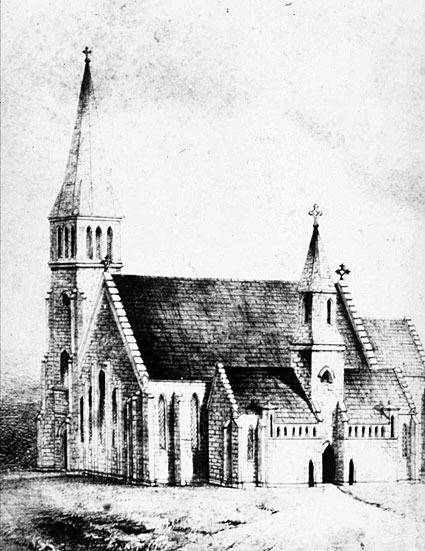
'St Mark's Church Collingwood'
Lithograph by James B. Philp, showing the architect's projected design,
printed by Macartney & Galbraith, 1853
[La Trobe Collection, State Library of Victoria]
The church was consecrated in January 1863, and the gallery and stairs on the east side were completed in 1865 to the design of Leonard Terry, the diocesan architect.3 The massive square tower and broach spire, designed by Charles Webb, were added in 1874-75 on the (liturgical) north-west corner.4

The massive square tower and broach spire,
designed by Charles Webb and added in 1874-75
[Photograph by Simon Colvin (May 2006)]
The original school buildings, which dated from 1849 and 1852, were re-located from the George-street side to the opposite side of the church in 1891.5

St Mark's Church and School (1861-62)
[Photograph by Davies & Co, Melbourne (SLV Image H687)]
First Organ.
In January 1854, the Church Committee accepted an offer from Mr James Blackburn, who was a Trustee of St Mark's as well as the architect, for the use of a small pipe organ, which they could purchase for £100 if it were found suitable.6
The organ appears to have been a second-hand instrument in need of considerable repairs. Prior to the opening of the church, there was a payment to Henry John Izard (April 1854) for "tuning and regulating and repairing and fixing Peddles of St Mark's Organ", to George Hughes (January 1855) for "repairing Bellows from Organ at St Mark's Church" and to H.P. Nicholas (January 1855) for "erecting organ, repairing pipes, conveyances, backfalls, trackers, etc, and erecting platform".7
One report of the opening of the church in January 1855, states that the "organ is eight stopped, and is apparently one of very great power"8 and another described the positioning of the organ:
At the foot of the church is a magnificent organ, and disposed on one side of it the choir.9
This instrument was removed at the time the second organ was installed. Its subsequent fate is unknown.
Second Organ.
The second organ at St Mark's was a two-manual chamber organ built by Forster & Andrews of Hull, said to have 'originally belonged' to Mr J.T. Charlton.10 It was installed at St Mark's in 1855, having served from 1853 at the Athenaeum Theatre in Melbourne. Like the first organ, it was located at the rear of the church. It was moved in 1877 to the Methodist Church, Richmond, and in 1888 was rebuilt by George Fincham and installed in St Augustine's Anglican Church, Shepparton. It has since been broken up.
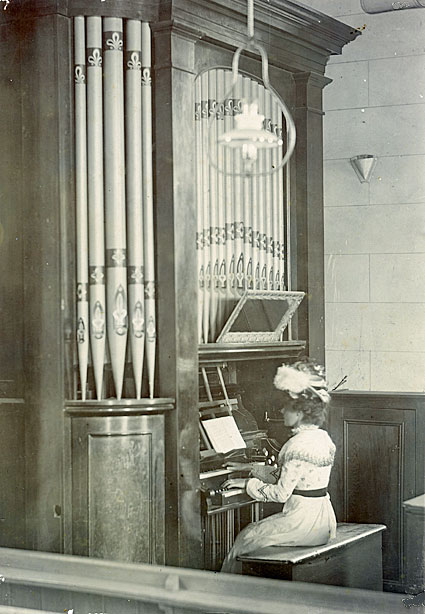
The Forster & Andrews organ at Shepparton, c.1895
[Photograph courtesy of Wangaratta Diocesan Archives,
Charles Sturt University, Wagga, NSW]
Third Organ.
The third organ in St Mark's Church was built by William Anderson of Melbourne and opened on 1 November 1877.11 This was the first organ to be located at the east end of the church, occupying the farthest bay on the south side. It was rebuilt by Hill, Norman & Beard (Aust) Pty Ltd in 1963, and installed in 1999 at St Francis-in-the-Fields Anglican Church, Mooroolbark.

The William Anderson organ of 1877
[Photograph (undated) from St Mark's Church Records, 1847-1982
(State Library of Victoria MS 11391), Box 1990/MCFB 4]
Present Organ.12
The present organ in St Mark's Church was built in 1938 by Harrison & Harrison of Durham, UK, for St Luke's Church, Cowley, on the outskirts of Oxford. The instrument had become redundant owing to the closure of the church, which had been built by Lord Nuffield for the employees of the Morris car factory nearby.

The 1938 Harrison & Harrison organ at Fitzroy
[Photograph by Peter Jewkes (1999)]
It was during major restoration work at St Mark's in the 1990s that the Vicar at the time, Fr Tony Noble, asked Peter Jewkes of Sydney to quote on rebuilding the existing Anderson/Hill, Norman & Beard organ. Through his longtime friend and associate, Michael Latham, Jewkes was aware of the existence of the redundant organ in Cowley, and had already recommended it unsuccessfully to St Francis' Catholic Church, Paddington in Sydney. Presented with the possibility of obtaining the organ from Cowley, Fr Noble immediately expressed interest, and visited the Cowley church on 9 February 1998 along with Peter Jewkes, Michael Latham (who regularly tuned for Harrison and Harrison) and the Oxford Diocesan Secretary. Apart from the cost of packing, shipment and installation, the organ was effectively given to St Mark's Fitzroy by the Diocese of Oxford, along with the cross and carved figures from the rood screen at Cowley, which are now located at All Saints' Anglican Church, East St Kilda.13

The interior of St Luke's Church, Cowley, Oxon
[Photograph from an undated postcard.]

The rood screen and organ at St Luke's Church, Cowley
(The cross is 15ft high, and Sts Mary and John are each 7ft high)
[Photograph by Michael Latham (c.1997)]
The spacious Oxfordshire church was a notable example of interwar Gothic, designed by local architect Alderman H.S. Rogers. Harold Rogers was a noted Oxford architect who is reported to have written the following about the organ case in 1952: "The organ case is of Crown Wainscot Oak stained down very dark – as is all oak furniture of the church. It was made by A R Mowbray & Co Ltd, of Oxford, who also made the choir seats and communion rail." Elsewhere, Rogers wrote (to Cuthbert Harrison) "Do you really think it [the case] is worth illustration? It satisfies myself, and I believe fulfils its purpose without fuss."14 The case measures 25ft 6in high and 11ft 6in wide.
The organ was designed by Dr (later Sir) Thomas Armstrong, who was Director of Music at Christ Church, Oxford,15 where the organ at the time was a four-manual Father Willis rebuilt by the Harrison firm. Harrisons had built many organs in Oxford and was considered the pre-eminent British organbuilding firm in the interwar era.
St Mark's was highly fortunate to acquire the organ, which was in mint condition and had escaped the ravages of the 60s and 70s unscathed. Mark Venning, Managing-Director of the Harrison firm, noted in 1997 that "the pipework is splendid, suffering only from dirt. It is totally original and no revoicing whatsoever has taken place. The Contra Oboe was quite a feature of our small organs of the period. The organ was, of course, built just after Arthur Harrison's death, but his influence was still very strong and the musical quality is excellent – the voicing would have been in the safe hands of Fred Howe … the blend and balance of an organ like this are special, and give far more versatility than the specification would suggest."16

Fred Howe, head voicer of Harrison & Harrison, 1936-1964
[Photograph (1960) from Laurence Elvin, The Harrison Story (author, 1973)]
It is an instrument of the highest technical and tonal quality and is contemporaneous with such prestigious organs as Westminster Abbey and Winchester Cathedral. Strangely, it is the only 20th century example of the Harrison firm's work in Australia. It is not clear why this is so, as the firm had an international reputation. While we have examples of the work of Henry Willis III in Melbourne and Brisbane, and of course many examples of instruments from Hill, Norman & Beard (built both in London and Melbourne) at this time, it is evident that this must have satisfied the needs of the Australian market for English organs of high quality. The Harrison firm was probably entirely preoccupied with meeting the needs of local markets and did not seek to advertise their instruments more widely. It did not consider tendering to build the Melbourne Town Hall organ.
While Harrisons' instruments were expensive, no expense was spared to achieve optimum results. This is particularly evident in the lavish use of materials, spacious layout, immaculate voicing, quality of engineering and overall solidity of construction. At St Mark's, the two slider chests have mahogany tables and upperboards, while the console is of richly figured oak, with thick ivory keys and deeply engraved drawknobs. The two double-rise reservoirs are constructed from very thick timber, there are four concussion bellows to stabilise the wind, while the pipe scales are very generous. The pneumatic actions are meticulously laid out and all parts are easily accessible for maintenance. All is constructed in the grand manner: the top of the spacious swell box is 23ft 9in above floor level while the building frame is massive and extremely solid, giving the impression of a cathedral organ in miniature.

The two slider chests during restoration in Sydney, late 1998
[Photograph supplied by Peter Jewkes]

The pneumatic coupler machine being stripped down
during restoration in Sydney, late 1998
[Photograph supplied by Peter Jewkes]
The organ is typical of the multum-in-parvo designs which the Harrison firm specialised in building in the earlier half of the present century. In such instruments, the grandeur of a large organ is suggested from a minimal number of stops, these usually including a manual double (reed or flue) and a strong chorus reed, the whole designed to have a considerable dynamic range. Such concepts were strongly promoted by Lieutenant-Colonel George Dixon, English organ architect and tonal expert.17
The instrument has been able to be accommodated within St Mark's in an almost miraculous manner, given its very tall configuration. At Cowley, the organ occupied a lofty chamber to the south of the chancel, which was a continuation of the arcade of the south aisle. At St Mark's, an identical situation prevails and in fact the aisle roof appears higher than that at Cowley. This has permitted the original configuration of the instrument to be retained almost exactly, with the exception of the relocation of the pedal Dulciana 16ft to the back wall of the space at Fitzroy and some internal open basses on the great removed to a new off-note pneumatic chest on the side of the swell box. This siting is one bay west of that occupied by the previous William Anderson/Hill, Norman & Beard instrument.

Side Elevation Drawing of the organ at St Luke's, Cowley, Oxon
[supplied to Peter Jewkes by Harrison and Harrison, c.1997]
Following the removal of the instrument from Cowley by Harrisons and its shipping to Sydney, the whole has been meticulously restored by Peter D.G. Jewkes Pty Ltd, of Ermington, New South Wales. This has involved the complete dismantling of the triple-stage exhaust tubular-pneumatic actions. The pneumatic leather work had to be carefully replaced owing to deterioration, involving the traditional Harrison processes of napping (to slightly abrade the surface of the leather, to improve adhesion) and doping (to seal the surface against leakage and offer protection). Apart from the key actions, the diaphragm manual coupling actions, the slider machines, combination actions, four concussion bellows and the two double-rise reservoirs have all been carefully releathered. The pneumatic tubing was in excellent condition, having been supported in carefully constructed tube trays and then splayed out to the underactions and bound together with black cotton tape to prevent sagging.
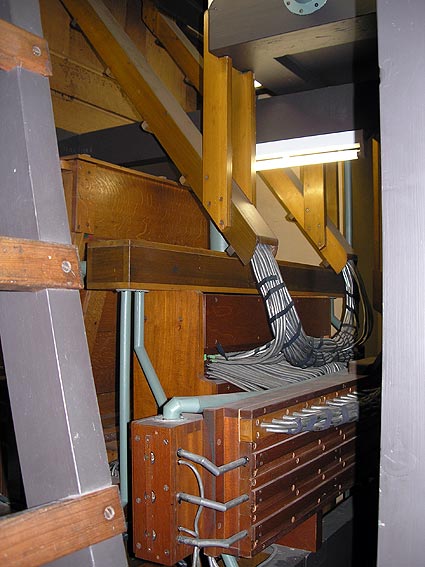
Wooden trays to support the pneumatic tubing
[Photograph by Simon Colvin (May 2006)]
The pipework was also in immaculate condition and required minimal repair and regulation. It is interesting to note that the treble pipes of the Claribel Flute are fitted with metal tips, and the larger wooden pipes have butterfly valves, all to facilitate careful regulation. The pipework is very generously scaled, the Open no 1 having a diameter of 7in at CC while the Subbass 16ft is not far short of a respectable open wood.

Pipework of the Great Organ
[Photograph by Simon Colvin (May 2006)]
The internal framing, swell box and larger wooden pipes are finished in the Harrison house-style paint – a dark brown colour while the zinc trunking has been painted in a gray-green colour.
The massive oak casework has an oiled finish and its dark colour is a good match for the adjacent furnishings at St Mark's. Some additional oak panelling has been fitted to the projecting sides of the upper case, where this section had been surrounded by masonry at Cowley. At the side of the instrument, one of the traceried screens at St Mark's has been ingeniously refitted as a swinging door giving access to the interior of the instrument, while above this has been placed an original dummy side façade of zinc pipes.
Installation of the organ began at Fitzroy in early August 1999 and the work largely completed by the end of September. The pipework was in such an excellent state that only minimal regulation was required.

The interior of St Mark's Church
[Photograph by Simon Colvin (May 2006)]
The end result is an organ which looks as if it was built specifically for St Mark's. The oak case, its dignified proportions and restrained details, matches to perfection the adjacent screens and woodwork. Indeed, even the case mouldings read through to the adjacent gallery fronts. The generous overhang to the upper case ensures that the pipework for the great organ is located well forward and speaks very directly into the building. The casework entirely surrounds the zinc façade pipework which has organ metal mouths embellished with the typical Harrison leather 'cupid's bow' to the polished plain metal upper lips.
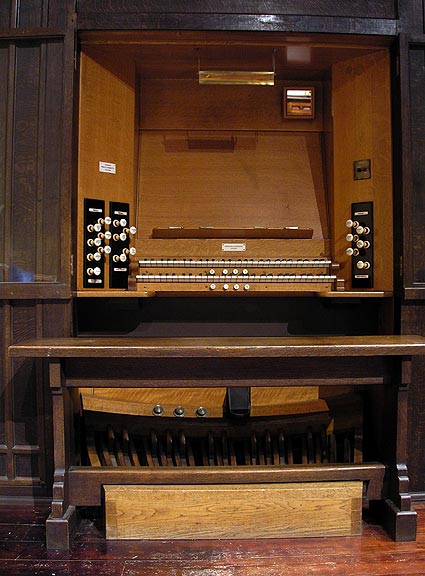
The console of the Harrison & Harrison organ
[Photograph by Simon Colvin (May 2006)]
The console is a model of comfort and convenience. The feel of the keyboards is excellent and the response (speed and repetition) of the action is extraordinary, surpassing most electric actions. Not for nothing did Harrisons consistently produce exhaust pneumatic actions for decades! The thick keys, curved keycheeks, ivory knobs on ebony jambs, massive bench and pedalboard and polished light oak panelling all add up to a sense of real anticipation for the player.
The scale of the pipework is ideally suited to St Mark's, which has a very lofty and broad nave, exposed wooden floors throughout and a pleasing resonant acoustic. The instrument offers exemplary support to the modern Catholic liturgy as practised at St Mark's, providing an uplifting accompaniment to congregational singing and the ability to create magical moments at quiet times in the Mass.
The great chorus is based upon the Open No 2, which is of singing quality and blends admirably with the very bright 4 and 2fts, both of which have a melodic rise to the trebles. Indeed, the 4ft suggests a 2ft and the 2ft a 1ft, so this sense of treble ascendancy is very welcome in the absence of compound stops. The large Open adds richness and warmth, and although voiced with leather upper lips, is not opaque in any way. The Claribel Flute is a delightful solo stop and may be used to accompany a number of combinations on the swell. The swell is enclosed in a very thick box which effectively cuts back the sound to a whisper when closed: the dynamic range is colossal. The fluework consists of a bright Violin Diapason, chirpy Lieblich Gedeckt, soft and reedy Echo Gamba and a bright (cylindrical) Gemshorn. The two reeds are a special feature of the instrument – the restrained and smooth Contra Oboe (with full-length bass) and a very full and bright Cornopean, fitted with harmonic trebles, almost suggesting a small Tuba when played in single notes and one of the finest reeds in Melbourne. The pedal consists of but two ranks: a very soft and purring Dulciana 16ft which sounds spellbinding under the swell Echo Gamba with the box closed; and a very large scale Subbass which offers considerable weight and definition.
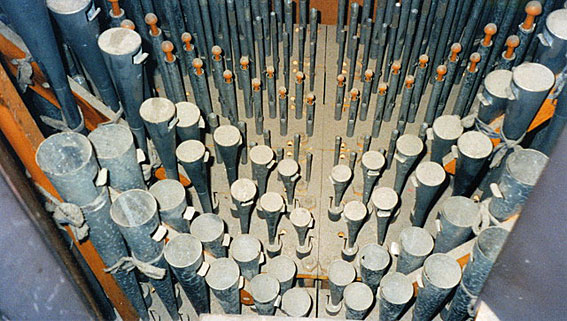
Pipework of the Swell Organ, viewed at Cowley,
showing the Cornopean 8ft and Contra Oboe 16ft in the foreground
[Photograph by Peter Jewkes (February 1998)]

Right-hand end of the Pedal pipework, showing the
Dulciana 16ft, now located at the rear of the organ
[Photograph by Simon Colvin (May 2006)]

The organ during installation at Fitzroy, showing the
pneumatic tube runs between the console and the Great Organ
with the Subbass 16ft pipes beyond
[Photograph by Peter Jewkes (1999)]
Overall, the sound is extremely beautiful, with a strong sense of refinement and richness. It is very distinctive in quality and instantly recognisable as the 'Harrison sound'. There is gravity, brightness, ample colour and a striking dynamic range. Full organ, with Open no 1 plus full swell and octave coupler is in no way oppressive and fills the church effortlessly from its privileged position.
Peter Jewkes and his team are to be commended for completing such a splendid restoration with painstaking attention to detail. Father Tony Noble, Vicar of St Mark's [1999], must also be congratulated for his outstanding vision in seeking a worthy instrument for St Mark's and indeed masterminding the restoration of the building. With its spacious Early-English Gothic nave and soaring broach spire, it now rates as one of Melbourne's finest churches of any period and with a perfect organ to match.
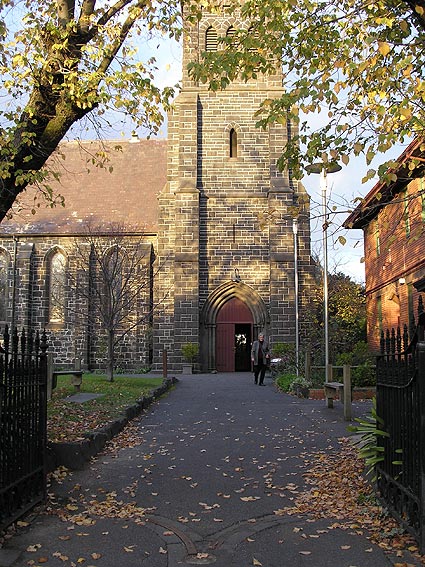
The entrance to St Mark's Fitzroy from George Street
[Photograph by Simon Colvin (May 2006)]
The instrument has been classified by the National Trust of Australia (Victoria) as an instrument of great significance to our organ heritage, and carries the following citation:
A two-manual organ of 14 stops built in 1938 by the leading English firm of Harrison & Harrison for St Luke's Church, Cowley, Oxford. The instrument was donated to the church by Lord Nuffield, whose motor works were nearby, and its designer was Dr (later Sir) Thomas Armstrong. It was moved from its original location and shipped to Australia in 1998. The only 20th century example of a Harrison organ in Australia, it is notable for its intactness, its constructional and tonal excellence, and its massive architect-designed oak case.
The organ was dedicated during Solemn Mass on Sunday 31 October 1999, at which Peter Jewkes provided the accompaniment, and the opening recital given by Lindsay O'Neill on the afternoon of the same day.
Click here to download an mp3 (3.8MB) of "Praise to the Holiest" (Gerontius)
as sung at Lindsay O'Neill's funeral service with Peter Jewkes at the organ
| GREAT ORGAN Large Open Diap Small Open Diap Claribel Flute Octave Super Octave SWELL ORGAN Violin Diapason Lieblich Gedeckt Echo Gamba Gemshorn Contra Oboe Cornopean PEDAL ORGAN Subbass Dulciana Flute COUPLERS Swell to Great [Swell] Octave Great to Pedal* Swell to Pedal* |
8 8 8 4 2 8 8 8 4 16 8 16 16 8 |
[harmonic trebles] A A |
*mechanical manual to pedal coupling action
Compass: 58/30
tubular-pneumatic action
3 thumb pistons to Great
3 thumb pistons to Swell
3 toe pistons to Pedal
Reversible thumb pistons for:
Swell to Great
Great to Pedal
Balanced mechanical swell pedal
Pitch: C = 517 cps @ 60 degrees Fahrenheit
Wind pressure: pipework 3 1/2in; action wind 7 in.
Discus blower.18




Console details of the 1938 Harrison & Harrison organ
[Photographs by Christopher Luke]
* OHTA acknowledges the assistance of The Revd Clarence Bester, Associate Rector of St Augustine's, Shepparton, and Mr Timothy Williams, Wangaratta Diocesan Registrar, for their part in locating the photograph (c.1895) of the Forster & Andrews organ in the Wangaratta Diocesan Archives. The finely dressed lady at the console is thought possibly to be Miss Flo Vibert.
1 The Argus (2 July 1853), p. 3.
2 The Age (20 January 1855), p. 5 & (23 January 1855), p. 5.
3 The Argus (7 Jan 1863), p. 5; The Argus (3 April 1865), p. 3.
4 The Argus (21 November 1874), p. 10; Church of England Messenger (5 August 1875), pp. 3-4.
5 The Church of England Record for the Diocese of Melbourne, vol. 3, No. 36 (December 1859), pp. 131-32; Souvenir: St Mark's Fitzroy, 1853-1923 (brochure, Aug 1923), pp. 4, 6, 10.
6 St Mark's Church Records, 1847-1982 (State Library of Victoria MS 11391) - Committee Minutes (6 January 1854) - box 1957/2.
7 Receipts dated 15 April 1854, 23 January 1855 and 22 January 1855 respectively, cited in Fincham/Matthews Collection (State Library of Victoria MS 9423), "Notes" D21, D8.
8 The Melbourne Morning Herald (22 January 1855).
9 The Age (23 January 1855), p. 5.
10 E.N. Matthews, Colonial Organs and Organbuilders (Carlton: Melbourne University Press, 1969), p. 134.
11 Loc. cit.
12 Much of the account of the present organ by John Maidment was published first in Organo Pleno (December 1999), pp. 8-11. It was partially reprinted in OHTA News, vol. 24, no. 1 (January 2000), pp. 15-16, and modified for OHTA's Melbourne Organ Weekend, 21-22 October 2000.
13 Personal communication to Geoffrey Cox from Peter Jewkes, 2016.
14 Letter from Mark Venning, Managing Director of Harrison & Harrison, Durham, UK to Peter Jewkes, 23 December 1997.
15 Loc. cit.
16 Loc. cit.
17 Cecil Clutton and George Dixon, The Organ: its Tonal Structure and Registration (London: Grenville, 1950), pp. 116-119.
18 Specification and details supplied by Mark Venning of Harrison & Harrison to Peter Jewkes, c.1997.